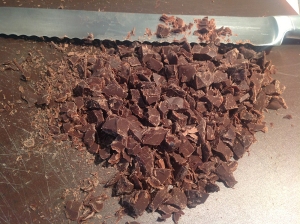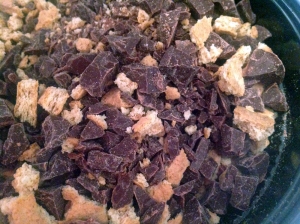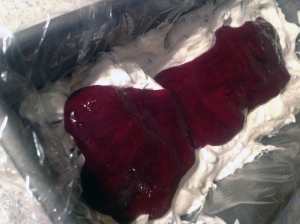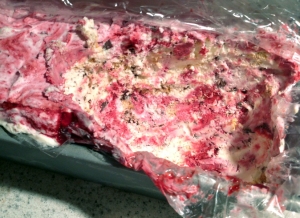It was love at first bite of the sweet corn tomalito from Chevy’s. I coveted it. I ordered fajitas just to get it. Once, the server forgot it. I sent her back to get it. Sure, it wasn’t perfect — I often found it dry. And the portion was scanty. But it tasted so good.
So when Chevy’s put out a cookbook, I bought it.
Five years (possibly more…) later, spurred by a dozen ears from my newfound fresh crack — I mean corn — dealer, I set about making it.
First, the corn. The Pennington (NJ) Farmers Market includes Kerr’s Korn and this week, he had what he calls a “one year wonder,” a variety named “Rembrandt.” I asked what that meant and we chatted a bit about it. I learned that the seed companies often put out a variety for only one year, usually claiming to have “lost the parents” when a farmer tries to re-order for the next season. According to Kerr’s, this invariably happens with the best varieties they’ve ever grown. Why? I asked. That seemed to make no sense. He mused that, because the seed companies largest customers are the large “agribusiness” corn growers, they hold a great deal of sway, and if they don’t like a variety or don’t want it for the next year or find it’s too hard to grow in high volume, the seed company will often drop it. With a twinkle in his eye, as he bagged up my 13 ears (yeah, I was going to buy 6, but hey, I’m never going to taste it again!), he said, “I think they just don’t know how to grow it.” Word.
Now, as is typical for me, I can’t make much of anything by the recipe. Plus, the recipe calls for fresh prepared masa, and I don’t have a dealer for that — yet. So, I’ve done some work to substitute the more readily available masa harina (the recipe suggests the substitution, but is vague on how to actually do it), added chives to the mix, messed with a few measurements, and narrowed down the baking time. Plus, some important warnings so you don’t get caught short like I almost did, and my hints to make it successful the first time.
The result is creamy but textured, corny, and just plain addictive. This is a great potluck dish.
 Sweet White Corn Pudding
Sweet White Corn Pudding
adapted by CSAgourmet from “Chevy’s Fresh Mex Cookbook”
Serves 8-10 or so as a side dish
6 cups fresh white corn kernels cut from the cob* with cob scraped for milk (this was exactly 6 ears for me, but my ears were long and large, so you may want to buy 8 just to be sure). Of course, you can use yellow or bicolor corn, you just may have to adjust the sugar if it isn’t as sweet as the white.
3/4 cup milk
1 stick unsalted butter (not softened)
1/2 cup masa harina
1/3 cup water (adjust this if your masa harina directions say to use more or less water per 1/2 cup masa harina; I used Maseca brand)
2/3 cup sugar
3/4 cup cornmeal
3/4 tsp baking powder
1 tsp salt
10 chive blades
Before you even preheat the oven, make sure you’ve got the pans you need. This pudding bakes in a water bath, so you need a 13x9x2 pan AND a larger pan that the 13x9x2 fits in without touching sides. That pretty much means a rectangular turkey roasting pan, but I got it done with my large lasagna pan.
Now you can preheat the oven to 250 degrees. In a food processor, puree 4 cups of the corn kernels with the milk until smooth (but there will still be a bit of texture). Reserve the other two cups of corn. Set aside the pureed corn in a large bowl (you will be mixing everything into this bowl eventually). In the processor, combine butter, masa harina, water, and sugar for about 3 minutes until smooth.
To the large bowl with the pureed corn, add the cornmeal, baking powder, and salt. Add masa harina mixture from the food processor into the large bowl. Snip chives (1/8″ lengths) into the bowl with the reserved 2 cups of corn kernels and toss to mix. Add corn and chive mixture to the large bowl containing all the other ingredients. Mix gently, but well. Pour into 13x9x2 baking dish. The mixture should pour easily. If it is too thick, thin with a bit of milk. Cover tightly with foil.
Open the oven and place the larger pan on the rack. Then place the 13x9x2 pan inside the larger pan. Fill larger pan with water until it is 3/4″ up the sides of the 13x9x2 pan. Gently slide into the oven. Bake for about 1 hr 45 min until the pudding sets (original recipe says 175 degrees F on an instant read thermometer — my instant read died, so I eyeballed it). This will give you a smooth, luscious pudding.
If you like a bit of a browned crust, I think you could pull it out a few minutes early and toss it under the broiler to brown. Don’t leave it under there too long or you’ll dry out the pudding and lose the smoothness.
Scoop out to serve. Mmmmm. Enjoy!
Note: I actually think this pudding is better the second day. The chives mellow and the texture gets even better. I left the pudding in the pan, covered it, and stashed it in the fridge. A quick per-portion reheat in the microwave warmed it without any loss in quality.
*Great tip I found on the interwebs — place the corn end in the hole of your Bundt or tube pan and then cut down. Corn stays stable and the pan catches all the kernels.
 Blood Orange Granita
Blood Orange Granita
















